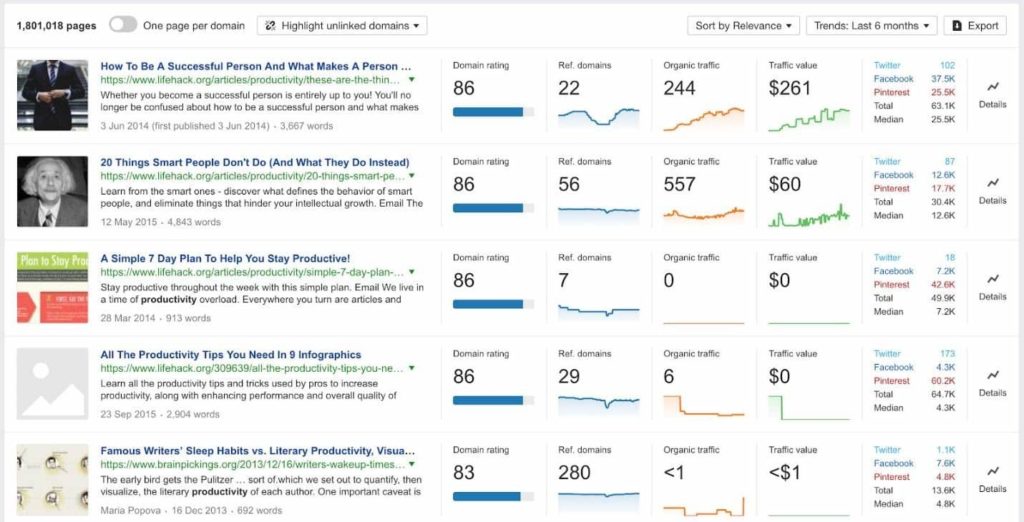There comes a time when you don’t know what topic to cover. This usually happens when you aren’t using a content calendar. Content marketing relies on content. You have to create new content to be at the top of your game. Content generation becomes too big of a problem when you run out of content and don’t know how to come up with content ideas to keep the ball rolling.
Creating and publishing quality content on your blog, YouTube channel, social media, and everywhere else is the backbone of your content marketing strategy. You can’t afford to stop publishing new content. It has to be produced consistently.
Here is a list of the proven techniques that will help you come up with content ideas to keep your content calendar filled all the time:
1. Use a Keyword Research Tool
I’m a big fan of keyword research tools (both free and paid) when it comes to coming up with content ideas. The best thing about these tools is that they don’t just throw random keywords, rather they give you content ideas based on existing content that’s published out there.

Ahrefs, for example, has a tool called Content Explorer that helps you generate content ideas like a pro. You can find content based on any keyword, apply filters, and see how well the content is performing in terms of backlinks, shares, and more:
So, if you find a topic that hasn’t been published in recent years on any of the leading blogs, you can come up with an updated version of the same.
When you use a keyword tool, you know upfront how well content is expected to perform because you can analyze the metrics of the existing content pieces. And the best part: You can identify content gaps.
These features are offered by all the leading keyword research tools such as:
- SEMrush
- Google Keyword Planner
- Longtail
- Keyword.io
- Buzzsumo.
2. Competitor Spying
If you are using a premium keyword research tool, you’ll be able to analyze your competitors and generate content ideas in no time.
However, if you aren’t using any such tool, you can manually check your competitors and see what type of content they’re publishing. This is a perfect way to come up with content ideas at no cost.
Look for topics and titles that you haven’t covered yet. You’ll find a lot of content ideas if you scan a few of your competitors. A good idea is to analyze the performance of the content so that you cover topics that are proven to perform well.
How to do it?
Use the following indicators to quickly measure the performance of a competitor blog post manually:
- Look for social shares count (if the counter is enabled). A lot of shares mean people like this content
- Check the number of comments. A high number indicates high engagement
- Has the article been republished or revised or updated? If so, this indicates that it is high-performing content that your competitor wants to keep updated
- Is there any special effort made by the competitor for the content such as graphics, download, checklist, research, etc.? If so, this indicates high performance because nobody will spend money on low-performing content.
3. Use Analytics Tools
Nothing works better than your analytics tool when it comes to finding content ideas. Go ahead and check your analytics tool to see what type of content works best and simply recreate them or find relevant topics.
Google Analytics and Google Search Console are the two best tools to generate content ideas.
Head to Google Analytics > Behavior > Site Content > Landing Pages to find landing pages that visitors land on:
Find content with a high number of entrances and a low bounce rate. This indicates that your target audience lands on this page and engages with it. Create similar content to drive more traffic and engagement.
Google Search Console also provides you with some great ways to identify top content on your website that you can recreate or improve. Click Performance > Queries and look at the CTR column:
Queries with high CTR mean your target audience clicks your search result for it. You can create a related article targeting a relevant keyword to rank multiple pages for this query.
Similarly, head to Pages to identify pages on your website with high CTR and clicks:
You don’t have to recreate top-performing content rather take a different approach such as:
- Create the content on a similar topic and interlink both the articles
- Create a revised and updated version of the same content without removing the existing one
- Repurpose your top-performing content
- Use it to create content for other channels e.g. social media.
4. Follow Trends
Do you follow trends in your industry? You should.
Because not only you’ll be able to find trending topics but it also helps you prove your authority.
Here is an example of how a Norwegian airline promoted flights to Los Angeles using a trend (Brad Pitt and Angelina Jolie split):

It isn’t all about trends and news in your industry. You have to keep an eye on leading global trends and find a way to link them to your industry. You can use tools to find trends and trending news around the globe:
- Google Trends
- Buzzsumo
- Feedly
- Exploding Topics
- Twitter Trends.
5. Ask Your Audience
The smartest way to come up with content ideas is to ask your audience. This is a sure way to create content that your audience is already craving for.
Here is an example of how to ask your audience for content ideas:
You can ask about broad topics (as in the example above) or you can use specific content ideas or topics. You can use social media, email, or any other channel to conduct a short survey to find what your audience is interested in.
It is an instant and free technique to generate content ideas whenever you want.
Conclusion
Now that you know the 5 best ways on how to come up with content ideas, it is time to start filling your editorial calendar. Ideally, you need to use all of these techniques on a regular basis to have a good poll of topics to cover.
Don’t wait for your editorial calendar to get empty. Keep it filled and make sure you have at least a month’s topics and content ideas sitting in your calendar at any time.
Featured Image: Pexels






